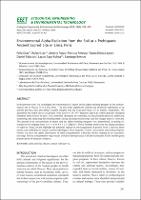Environmental Alpha Radiation from the Soil at a Prehispanic Ancient Sacred Site in Lima, Perú

View/
Author(s)
Díaz, Félix
Liza, Rafael
Rojas, Jhonny
Pereyra, Patrizia
Lopez, Maria Elena
Palacios, Daniel
Sajo-Bohus, Laszlo
Benites, Santiago
Date
2023Metadata
Show full item recordPublisher
Ecological Engineering & Environmental Technology (EEET)
Journal
Ecological Engineering & Environmental Technology
Abstract
In the present work, we investigate the concentration of radon and its alpha-emitting progeny at the archaeological site of Huaca 20 in Lima, Peru. The site holds significant cultural and historical importance as an ancient pre-Inca ruin, providing valuable insights into the lives and rituals of its former inhabitants. We quantified the radon levels accurately with passive CR-39TM detectors deployed within specially designed chambers at the site for 28 days. In a controlled laboratory environment, we processed the detectors afterward, examining and analyzing the resulting tracks using advanced microscopy and the ImageJ analysis software. The ground-level concentration of radon and its alpha-emitting progeny was determined, revealing elevated levels ranging from (2.4 ± 0.6) to (8.9 ± 0.9) (kBq/m^3). These findings underscore the unique presence of radon at Huaca 20 and highlight the potential impact on microorganisms at ground level. Likewise, these results can contribute to studies on the radiological risks faced by visitors, excavators, and archaeologists. Finally, we show the spatial distribution of radon concentrations within the site by creating an iso-concentration map. The iso-concentration map reveals a relation between areas with elevated radon levels and the good preservation of funerary contexts.
Type
info:eu-repo/semantics/article
Rights
info:eu-repo/semantics/openAccess
Language
eng
Collections
- Ingeniería Ambiental [98]

